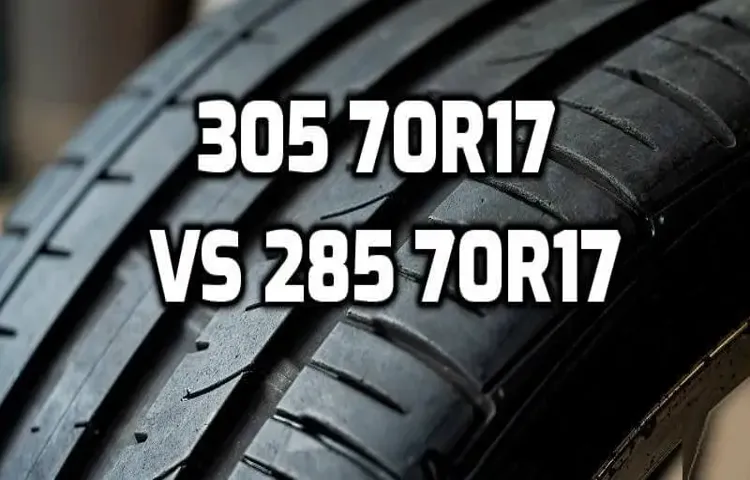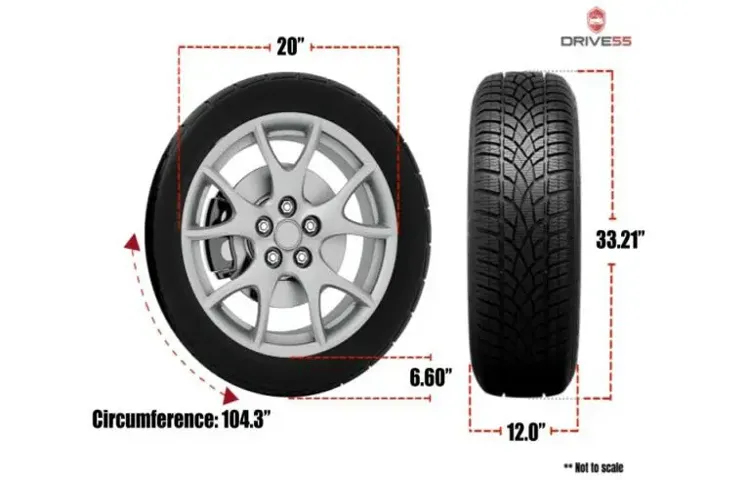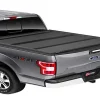Do you ever wonder what all those numbers and letters on your tire mean? If you’ve noticed “305” etched onto your rubber, don’t fret – it’s not a secret code or manufacturer’s signature. Tire size can be a bit confusing, but it’s important to understand what those seemingly random numbers indicate. The number “305” in tire size actually refers to the width of your tire in millimeters.
Essentially, it tells you how wide your tire is from sidewall to sidewall. But it’s not just about the width – there are other numbers and letters on the tire that specify things like aspect ratio, speed rating, and rim diameter. Understanding tire size is essential not only for ensuring proper fit and function, but also for making informed purchasing decisions.
Investing in the right tires for your vehicle can save you money in the long run, as well as keep you safe on the road. So, if you’re curious about what “305” means on your tire (or any other tire-related questions), stick around. This guide will break down all the essentials of tire size, making it easier than ever to understand what the numbers and letters on your tire really mean.
Table of Contents
Introduction
If you’re wondering about the tire size 305, the first thing you should know is that it refers to the width of the tire in millimeters. So, what tire size is 305? Well, a tire with the size 305/40R22, for example, would have a width of 305 millimeters and a sidewall height that is 40% of the tire’s width. The “R” indicates that the tire is a radial tire, and the number 22 refers to the diameter of the rim in inches.
These numbers may seem confusing, but they actually provide useful information that helps you choose the right tire for your vehicle. It’s always important to refer to your vehicle’s owner’s manual or consult with a tire professional to ensure that you’re choosing the right tire size for your specific make and model.
Explaining Tire Size
Tire size can be a confusing concept for many people. It’s important to understand what the numbers on the sidewall of your tire mean so that you can properly maintain your vehicle and choose the right replacement tires. The numbers on your tire represent the width of the tire in millimeters, the aspect ratio, which is the height of the sidewall as a percentage of the width, the rim diameter in inches, and the load and speed rating.
For example, a tire with a size of P215/65R15 95H would have a width of 215 millimeters, an aspect ratio of 65, a rim diameter of 15 inches, and a load rating of 95 and speed rating of H. Understanding these numbers will help you make informed decisions when it comes to purchasing and maintaining tires for your vehicle.

Breaking Down the Code: The First Number
If you’ve ever looked closely at a bar code, you’ll notice a series of numbers beneath the black and white lines. These numbers help identify the product and are essential for retailers and manufacturers. But do you know what those numbers mean? Let’s break it down.
The first number of the bar code indicates the type of product it represents. For example, a product with a bar code starting with a “0” indicates it’s a standard product, while a “1” means it’s a pharmaceutical product. A “2” represents items sold by weight, such as produce or meat, while a “3” is used for items sold by length or size, like lumber or fabric.
Knowing the first number of a bar code can provide valuable information about the product. So, the next time you’re scanning products at the grocery store, take a moment to decipher the meaning behind those numbers.
Understanding the Second Number in the Code
When it comes to understanding the second number in a code, it is important to know that it refers to the category of the item being identified. The first number typically refers to the manufacturer or producer of the item, while the second number signifies the specific type of product. An example of this is the Universal Product Code (UPC) used for scanning items at the grocery store.
The first six digits of the code identify the manufacturer, and the last five digits identify the specific product. This allows for easy tracking and organization of inventory. In other contexts, the second number in a code may refer to the version or edition of a product.
Overall, understanding the second number in a code can provide valuable information about the item being identified, making it a crucial aspect of coding systems.
What Does 305 in Tire Size Mean?
If you’ve been shopping for new tires, you may have come across the tire size 30 What does it mean? Well, tire size is made up of three numbers: the first number indicates the width of the tire in millimeters, the second number represents the aspect ratio (the height of the tire’s sidewall as a percentage of the width), and the third number is the diameter of the wheel in inches. So, with a tire size of 305, the width of the tire would be 305 millimeters.
It’s a pretty wide tire, typically found on larger vehicles like trucks and SUVs. It’s important to make sure you select the correct tire size for your vehicle, so always check your owner’s manual or ask a professional if you’re unsure.
The Actual Size of a 305 Tire
If you’re wondering about the actual size of a 305 tire, then you’re not alone. The number 305 in tire size actually refers to the width of the tire in millimeters. So, a 305 tire would be 305 millimeters wide, or approximately 12 inches.
However, it’s important to note that the width of the tire is just one factor in determining its size. The aspect ratio, which is the height of the sidewall as a percentage of the width, also plays a role. For example, a 305/70 tire would have a sidewall height that is 70% of the width, while a 305/40 would have a lower sidewall height of 40%.
This can affect the overall diameter of the tire, which can impact handling and performance. So, while the number 305 may give you a general idea of the width of the tire, it’s important to consider the other factors as well when selecting the right tire size for your vehicle.
Common Vehicles that Use 305 Tires
If you’re wondering what the number 305 means in tire size, it refers to the width of the tire in millimeters. That’s right—you can tell how wide a tire is at a glance just by looking at the number! Typically, 305 tires are pretty wide and are commonly found on heavy-duty vehicles like trucks and SUVs. But there are also plenty of sports cars and muscle cars that use 305 tires as well, since they offer superior grip and handling on the road.
Some of the most popular vehicles that use 305 tires include the Ford Mustang GT, the Dodge Challenger, and the Chevrolet Silverado. These vehicles benefit from the durability and stability that come from a wider tire base. However, it’s important to note that not every vehicle is compatible with 305 tires, so make sure to consult your owner’s manual or a trusted mechanic before making any changes to your wheels.
Conclusion
If you ask what tire size is 305, the answer is clear – a whopping 305 millimeters! But in reality, it’s not just a number. It’s a representation of size, power, and performance. A 305 tire size means you’re driving a beast of a vehicle, one that demands attention and commands the road.
So if you’re looking for a bold and powerful ride, a 305 tire size is definitely the way to go. Just make sure your rims are ready for a tire this big – you don’t want any blowouts on the way to showing off your impressive ride!”
FAQs
1. What does “305” mean in tire size measurements? A: “305” refers to the width of the tire in millimeters. 2. Can I use a tire size 305 on any car? A: No, tire size compatibility depends on the make and model of the vehicle. Always refer to the owner’s manual for the appropriate tire size. 3. What other tire sizes are compatible with size 305? A: It depends on the specific make and model of the vehicle. Refer to the owner’s manual or consult with a professional tire dealer for the best tire size options. 4. Are 305 tires considered to be wide tires? A: Yes, 305 is a relatively wide tire size that is commonly used for high-performance vehicles. 5. Are there any downsides to using a tire size 305? A: While wider tires can provide better handling and performance, they may also be more susceptible to hydroplaning on wet roads. 6. How do I know if a tire size 305 is suitable for my driving needs? A: Consider factors such as your driving habits, climate, and the make and model of your vehicle. Consult with a professional tire dealer for personalized recommendations. 7. Can I mix and match different tire sizes on my vehicle? A: It is not recommended to mix and match tire sizes on a single vehicle, as this can affect handling and safety. Stick to the recommended tire size for your make and model.



